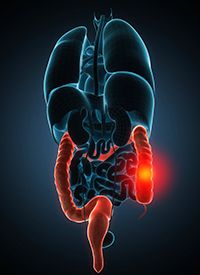Article
MSH3 IHC and Tetranucleotide MSI Analysis Should Not Be Routine in CRC
Author(s):
MSH3 immunohistochemistry and tetranucleotide analysis failed to demonstrate concordance in identifying microsatellite instability in a cohort of colorectal cancer cases at selected tetranucleotide repeats, suggesting that the dual assessment strategy is not ready for routine use in diagnostic workup.

MSH3 immunohistochemistry (IHC) and tetranucleotide analysis failed to demonstrate concordance in identifying microsatellite instability (MSI) in a cohort of colorectal cancer (CRC) cases at selected tetranucleotide repeats, suggesting that the dual assessment strategy is not ready for routine use in diagnostic workup, according to findings from a study that were published in Human Pathology.1
“Although tetranucleotide microsatellite instability is clearly evident in a subset of colorectal cancers, further development of validated sets of tetranucleotide repeats and either MSH3 or other immunohistochemical markers will be required in order to include elevated microsatellite alterations at selected tetranucleotide repeat testing in the routine evaluation of colorectal cancers in clinical practice,” wrote lead study author Andrew Laycock, a consultant pathologist at PathWest Anatomical Pathology, and coauthors in the study publication.
Screening for mismatch repair protein (MMR) expression via IHC is an important element of the diagnostic workup in pathology. Moreover, evaluation of MMR is commonly used to identify subtypes of CRC with genetic or sporadic forms of MSI.
Currently, MSH3 is not included in MMR panels although MSH3 aberrations are found in 40% to 60% of CRC cases and are associated with elevated microsatellite alterations at selected tetranucleotide repeats and worse prognosis.
To better understand the practicality of using such assessment tools in routine pathology practice, investigators performed MSH3 immunohistochemical staining and tetranucleotide MSI analysis in a cohort of 250 unselected CRC cases.
Tetranucleotide MSI was assessed by polymerase chain reaction for 6 previously characterized tetranucleotide repeats: CSFR1, D9S242, D11S488, D20S282, L17686 and MYCL1.
The cohort included 107 female and 143 male patients. Patients were a median age of 72 years (range, 30-94). Tumors located throughout the colon included those in the caecum (n = 44), ascending-transverse colon (n = 49), splenic flexure-rectosigmoid colon (n = 91), and rectum (n = 66).
The results showed that partial, complete, and focal loss of nuclear MSH3 and its cytoplasmic mislocalization was found in 67% of tumors, whereas MSI was found in 2 to 6 tetranucleotide repeats of a panel of 6 tetranucleotide repeats in 46% of cases.
Notably, the mean age of patients with elevated microsatellite alterations at selected tetranucleotide repeat–positive tumors was 71 years vs 67 years in patients with elevated microsatellite alterations at selected tetranucleotide repeat–negative tumors (P = .028). Additionally, elevated microsatellite alterations at selected tetranucleotide repeat were more commonly found in female patients (P = .0023).
The amount of elevated microsatellite alterations at selected tetranucleotide repeat–positive tumors decreased from the proximal to distal colon, with 61% and 63% of elevated microsatellite alterations at selected tetranucleotide repeat–positive tumors in the caecum and ascending/transverse colon, respectively. This amount decreased to 44% and 23% of elevated microsatellite alterations at selected tetranucleotide repeat–positive tumors in the splenic flexure/rectosigmoid colon and rectum, respectively.
Furthermore, the concordance between MSH3 IHC and tetranucleotide MSI results was 61.5%.
Moreover, MSH3 immunostaining was compromised in areas of tissue crush and autolysis, which are common in biopsy and surgical samples, further reducing its utility in routine pathology practice.
“Progress in the field, in particular the introduction of elevated microsatellite alterations at selected tetranucleotide repeat testing in pathology/clinical practice, will likely depend on coordinated efforts of multiple clinical and scientific disciplines to robustly validate and standardize methods and scoring of both immunohistochemical and molecular investigations. For routine diagnostic pathology, instability at more than a single microsatellite would seem to provide a greater reliability or robustness of testing procedures. However, the largely uncharacterized nature of genome-wide tetranucleotide MSI in elevated microsatellite alterations at selected tetranucleotide repeat CRC may impede development of testing panels with these properties at this time,” concluded the study authors.
Reference
- Laycock A, Kang A, Ang S, et al. Lack of correlation between MSH3 immunohistochemistry and microsatellite analysis for detection of elevated microsatellite alterations at selected tetranucleotide repeats (EMAST) in colorectal cancers. Hum Pathol. Published online September 16, 2021. doi:10.1016/j.humpath.2021.09.004






%20(2)%201-Recovered-Recovered-Recovered-Recovered-Recovered.jpg?fit=crop&auto=format)

%20(2)%201-Recovered-Recovered-Recovered-Recovered-Recovered.jpg?fit=crop&auto=format)
%20(2)%201-Recovered-Recovered-Recovered-Recovered-Recovered.jpg?fit=crop&auto=format)